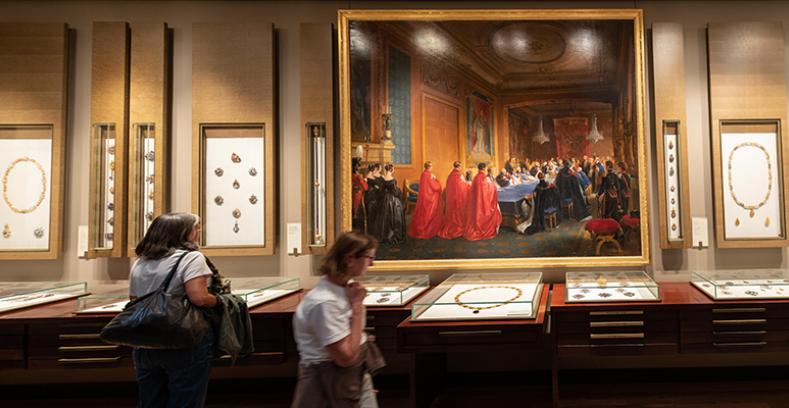
The world
The World
This world map of honors illustrates the diversity of the orders and decorations on display at the museum.
European orders reflect the development and evolution of early nations, from the medieval chivalrous orders, sometimes still awarded today (Order of the Garter, Order of the Elephant),
up to orders of merit such as the Legion of Honor.
Gradually, starting in the 19th century, the principle of orders and decorations spread to other continents,
and every country created its own set of rewards. While the orders of the Americas and Africa often drew
inspiration from European insignias, the Eastern orders renewed the forms of the traditional decorations.


Germany
In spite of the proclamation of the German Empire in 1871, Germany remained a mosaic of states, each with a distinct reward system until 1918.
Among the oldest of these princely orders is the Order of Saint Hubert of Bavaria, founded in 1444 by the duke Gerhard V, in memory of his victory in Ravensberg on Saint Hubert’s day. The order of chivalry fell into oblivion and was re-established in 1708 by Johann Wilhelm II, Elector Palatine, to become the first Bavarian order after the creation of the Kingdom of Bavaria in 1806 under the aegis of Napoleon I. It consisted of a single class with a collar.
The Order of the Black Eagle held the highest position in Prussia. Frederick I, elector of Brandenburg, founded this order of chivalry, named after the heraldic eagle of the kingdom, in 1701 at the time of his accession to the throne of Prussia. As of 1792, the knights obtained the Grand Cross of the Order of the Red Eagle, the second order of the kingdom, by right.
All of these princely and royal orders disappeared in 1918 with the fall of the German Empire. The Republic of Weimar (1918-1933) conferred commemorative crosses only. The Third Reich established its own decorations.
In 1949, Germany was divided into two states. The reward system of the German Democratic Republic copied the Soviet model. The Federal Republic of Germany founded an Order of Merit in eight classes, retained at the time of reunification in 1990.
Illustrations
Top, insignia of the Order of Saint Hubert of Bavaria
Bottom, badge of the Order of Merit
On the map, insignia of Knight of the Order of the Black Eagle of Prussia


Austria
The history of Austria is inseparable from the Habsburgs, who ruled the country from the 13th century until 1918. An archduchy in 1453, Austria expanded its territories through a series of alliances and in the 18th century became a major European power, whose apogee was the reign of the Empress Maria Theresa. The latter founded the first civilian and military orders, which complemented the Order of the Golden Fleece. The governance of this illustrious Burgundian order passed to the house of Austria in 1477, when Maximilian of Habsburg married Mary of Burgundy, then to Spain with Charles V. At the end of the War of the Spanish Succession, the Golden Fleece was claimed in 1712 by Austria and was thenceforth awarded by the Spanish and Austrian sovereigns. Since the fall of the Habsburgs in 1918, the Order, considered a legal personality under international law, has been conferred on a dynastic basis.
The Military Order of Maria Theresa, founded by the Empress Maria Theresa in 1757, ranks among the most prestigious military orders awarded in times of war.
The Order of Saint Stephen of Hungary was founded in 1764 by the Empress Maria Theresa, apostolic Queen of Hungary, to reward civil merits. Its name pays homage to the first king of Hungary, Saint Stephen, who received the apostolic crown from the pope in 1001.
Several other orders completed the honors of the Austrian empire during the 19th century but disappeared in 1918.
The Republic of Austria’s Order of Merit was instituted in 1952, replacing a first order for merit created in 1922.
Illustrations
Top, pendant of the Golden Fleece
Bottom, badge of Grand Cross of the Order of Saint Stephen of Hungary
On the map, insignia of Knight of the Order of Maria Theresa


Denmark
A dominant power in Scandinavia for many centuries, Denmark retained some ancestral orders throughout its turbulent history.
The Order of the Elephant, devoted to the Virgin, originated in a religious fraternity, the Order of the Mother of God, founded in the 15th century by Christian I of Denmark. Renewed in 1580 by Frederick II, the Order’s statutes established in 1693 by King Christian V are still in force. Originally limited to thirty Knights, the Order is now awarded to members of the royal family, heads of state and a limited number of other personages. The insignia may appear surprising but the white elephant carrying a tower, a symbol of purity and chastity, is one of the attributes of the Virgin. The Elephant jewel, worn on a blue sash, is suspended from the collar on days of ceremony. According to a rule common to the major orders of chivalry, it must be returned to the order upon the Knight’s death. On the reverse is inscribed the monogram of the reigning monarch.
The Order of the Dannebrog originated with the battle of Lyndanisse, won by King Valdemar II in 1219, during which the Danish flag, the Dannebrog, is said to have fallen from the sky.
King Christian V instituted this order of chivalry in 1671, and its statutes were established in 1693. In 1808, it became an order of merit with several classes, on the model of the Legion of Honor. The collar was then reserved for Grand Cross Knights and the insignia modified, featuring the monogram of the reigning monarch. There is a special class of Grand Cross with diamonds.
Illustrations
Top, jewel of the Order of the Elephant, with Frederick VI monogram
Bottom, insignia of the Order of the Dannebrog (pre-1808 version)
On the map, jewel of the Order of the Elephant


Spain
The Spanish orders reflect the major events in the country’s history. During the Reconquista, Catholic kings founded religious and military orders, including the Order of Calatrava and the Order of Santiago. Reunited to the crown in the 16th century, they took on the character of royal rewards.
The Habsburgs made the Golden Fleece the highest order of the kingdom. The governance of this Burgundian order of chivalry, founded in 1430 by Philip the Good, was transferred to the House of Habsburg in 1477. Charles V then bequeathed it to his son, King Philip II, in 1555. Abolished by the Republic in 1931 but recognized as a dynastic order, it was re-established as a state order when King Juan Carlos I acceded to the throne in 1975.
In the 18th century, the Bourbons gave the country several civil and military orders of chivalry, which were retained by successive political regimes. The Order of Charles III, instituted in 1771 by Charles III, is Spain’s highest civilian honor. The center of the insignias features the Immaculate Conception, inspired by the painting by Murillo. The motto is: “Virtute et Merito” (virtue and merit).
King Ferdinand VII founded the Order of Isabella the Catholic in 1815. Named in honor of the celebrated Queen of Castile and Léon, it was made to reward merits earned defending American possessions. Reformed in 1847, it became a universal order of merit. The insignia is an allegory of the reuniting of the old and the new worlds: two globes linked by a ribbon, and the Pillars of Hercules.
Illustrations
Top, pendant of the Golden Fleece
Bottom, badge of the Order of Isabella the Catholic
On the map, insignia of Grand Cross of the Order of Charles III


Finland
Once part of Sweden, Finland was a Grand Duchy of the Russian Empire from 1809 to 1917, then an independent republic in 1918 after a civil war lasting several months. It is at then that the first two orders were founded, with insignias illustrated by the painter Akseli Gallen-Kallela, eulogist of independence.
The Order of the Cross of Liberty, founded on March 4, 1918, on the suggestion of Carl Gustav Mannerheim, supreme commander of the armed forces, rewards services to the cause of liberation. Intended for honoring merit in times of war, it was not awarded between the war of independence and 1940. Its statutes, confirmed in 1944, now provide for awards in times of peace. It comprises two divisions, military and civilian, in five classes and a medal. It has been awarded only very exceptionally.
General Carl Gustaf Mannerheim, then regent of Finland, founded the Order of the White Rose in 1919 for meritorious citizens. It comprises five classes and a medal. The collar is its supreme distinction. Two-edged swords characterize the insignias, granted for merits earned on the battlefield.
Finland also has a third order, the Order of the Lion, founded in 1942 to complement the Order of the White Rose by rewarding eminent civilian and military merit. There are also commemorative medals.
The heraldic silver rose of the coat of arms of Finland is featured in the center of the insignias of the Cross of Liberty and of the White Rose.
Illustrations
Top, badge of Grand Cross of the Order of the Cross of Liberty
Bottom, badge of Grand Cross of the Order of the White Rose
On the map, badge of Grand Cross of the Order of the White Rose

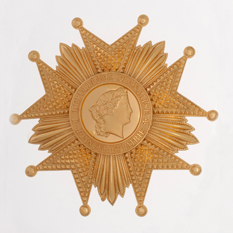
France
The creation of the orders in France, which occurred at a regular pace since the 14th century, follows the rhythms of the country’s history from the Middle Ages to our time. Henri III founded the most prestigious of the orders of the monarchy, the Order of the Holy Spirit, in 1578. At that time it was limited to 100 noble knights. It took precedence over the Order of Saint Michael, founded by Louis XI in 1469. The cross of the Holy Spirit, inspired by the cross of Malta, depicting the dove, spread its light over all Europe. Louis XIV founded the Military Order of Saint Louis, an order of democratic merit in 1693, and sparked a profound change in the principle of the rewards.
Abolished by the Revolution, the orders of the Old Regime were revived under the Restoration until Louis Philippe definitively put an end to them in 1830.
Founded in 1802 by First Consul Napoleon Bonaparte, the Legion of Honor is a modern order constructed on the principle of universality. Since its creation it has rewarded the highest civil and military merits. The famed white star affixed to a red ribbon has withstood all political upheavals. Only the central effigy has changed, adapting to the different regimes: Empire, Monarchy and Republic. The Legion of Honor has symbolized talent, courage, and devotion in the service of the Nation for over two centuries.
In 1963, General de Gaulle created the National Order of Merit, second national order, with the goal of refining the notion of merit and adapting the rewards to the new expectations of the contemporary world.
Illustrations
Top, insignia of Knight of the Order of the Holy Spirit
Bottom, badge of Grand Cross of the Order of the Legion of Honor (current version)
On the map, grand eagle of the Legion of Honor (First Empire)


United Kingdom
The British reward system is among the most comprehensive in existence.
Edward III created the Order of the Garter in 1348. It is still one of the most prestigious orders of chivalry in the world. The insignia is a velvet garter embroidered with the motto: “Honni soit qui mal y pense” (Shame be to him who thinks evil of it). From the collar, reserved for ceremony, hangs a figurine of Saint George, the patron saint of the kingdom, bringing down the dragon. A pendant known as “Lesser George” and a badge complete the insignias of the Order.
Other orders of chivalry in the United Kingdom include the Order of the Thistle (Scotland) and the Order of Saint Patrick (Ireland). Some have fallen into disuse, such as the orders of the British Imperial Viceroyalty.
The most important order of merit in the United Kingdom, the Order of the Bath, was founded in 1725. It is rooted in a medieval ceremony of the bath held on the eve of the dubbing of a knight. Reformed in 1815, it became the main reward for civil and military merits. Its motto, “Tria juncta in Uno” (Three joined in One), and the design of its medallion symbolize the union of the crowns of England, Scotland and Ireland.
The Order of Saint Michael and Saint George was founded in 1818 by the prince regent to reward services rendered to British interests in the Mediterranean. Since 1869 it has been the highest award for civil services in the diplomatic and international arena.
There are also numerous commemorative medals and military decorations, including the rare and prestigious Victoria Cross.
Illustrations
Top, Lesser George pendant
Bottom, badge of the Order of the Bath
On the map, Great George (collar pendant)


Italy
Each of the states that made up Italy prior to 1861 had its own orders reflecting its own history.
Charles VII of Bourbon, first King of Naples and Sicily (future Charles III of Spain) founded the Royal Order of Saint Januarius in 1738. This order of chivalry, inspired by the Order of the Holy Spirit, was the model for the Spanish Order of Charles III. The insignia depicts Saint Januarius, patron of Naples, holding the vials of his miraculous blood.
Italy was unified under the aegis of the dukes of Savoy, kings of Sardinia. Their orders, the Orders of Saint Maurice and Saint Lazarus, Military Order of Savoy, Sardinian Medal of Military Valor, then became the sole rewards of the kingdom, completed by new institutions such as the Order of the Crown of Italy.
The Supreme Order of the Most Holy Annunciation, founded in 1362 by Amadeus VI of Savoy, became the highest order of the Kingdom of Italy in 1861. This ancestral institution of chivalry, first named Order of the Collar, consists of a single Knight class. The insignia (a portrayal of the Annunciation) is worn on a gold collar with a badge. A Grande Collana is reserved for ceremonies. The order was abolished in 1951.
The Order of Merit of the Italian Republic, founded by decree of March 3, 1951, replaced the royal distinctions after the proclamation of the Republic in 1946. It has five classes and a higher title of Grand Cordon, restricted to heads of state, that includes a collar. In 2001, the original insignia of the Order was replaced by a version reminiscent of the Order of the Crown of Italy.
Illustrations
Top, insignia of the Order of Saint Januarius
Bottom, badge of Grand Cross of the Order of Merit
On the map, pendant of the Order of the Annunciation


Poland
The history and the evolution of the Polish orders faithfully reflect the country’s trials and tribulations. Until the 18th century, the electoral kingdom of Poland had no orders of chivalry, which were considered dangerous by the nobility, eager to safeguard its independence. King Augustus II the Strong, elector of Saxony, nevertheless succeeded in imposing the Order of the White Eagle around 1703-1705. This order ceased to be conferred in 1795 when Poland was split up. Renewed briefly in 1807 during the Grand Duchy of Warsaw, it, along with the country, were taken over by Czar Alexander I and transformed into a Russian order after the insurrection of 1830. Reinstated by the Polish Republic in 1921, it was abolished by the People’s Republic of Poland, and then reinstituted in 1992 as the highest Polish order. The insignia picks up the heraldic symbol of the kingdom: a white eagle perched on a red cross.
The second Polish order of chivalry, the Order of Saint Stanislaus, founded by King Stanisław August Poniatowski in 1761 and incorporated into the Russian orders in 1831, was definitively abolished in 1918. It inspired the Order of the Polonia Restituta, founded in 1921 and renewed in 1992.
Stanisław August Poniatowski also founded the Order of Virtuti Militari (military courage) in 1792, an order originally intended to reward acts of bravery on the battlefield. Abolished and recreated several times, it has adapted to each change of regime and was reestablished in 1992.
Illustrations
Top, badge of Knight of the Order of the White Eagle
Bottom, insignia of Knight of Virtuti Militari
On the map, insignia of Knight of the Order of the White Eagle


Portugal
An independent kingdom founded in the 12th century, head of a vast colonial empire, the House of Braganza governed Portugal from 1640 to 1910. In the wake of a series of domestic crises, the Republic replaced the Monarchy and re-established most of the orders in 1917-1918.
Portugal’s first orders, originally religious and military, were secularized in 1789. The ribbon of the Three Orders, in use since that time, combined the crosses of the orders of Christ, of Aviz and of Saint James of the Sword into a sole insignia, which are still awarded today. It symbolized the union of the office of Grand Master to the crown in 1551. It was reserved for the monarch, and now for the president of the Republic. It was exceptionally awarded to sovereigns and heads of state until the reform of 1962.
The Order of the Tower and Sword was founded in 1808 by the Prince Regent Dom João of Braganza to commemorate the arrival of the royal family in Brazil under the protection of a British fleet. Transformed into an order of civilian and military merit in 1832, it was abolished by the Republic then re-established. It is still the highest decoration of Portugal.
The kingdom had a charitable order for women, the Order of Saint Isabella of Portugal, founded by the Prince Regent in 1801 and reserved for noble ladies. They wore an insignia featuring the effigy of Saint Isabella, Queen of Portugal from 1282 to 1325. The order was abolished in 1910.
Illustrations
Top, badge of Grand Cross of the Order of the Tower and Sword
Bottom, insignia of the Order of Saint Isabella
On the map, insignia of Grand Cross of the Three Orders


Russia
Imperial Russia was introduced to Orders of Chivalry under the reign of Peter the Great. The earliest, the Order of Saint Andrew, was founded in 1698. It still occupies the first place in the hierarchy of Russian orders. Comprised of a single Knight class, it was initially awarded by personal decision of the tsar and reserved for the imperial family, an elite group of senior dignitaries and a few foreigners. It disappeared like all the other imperial orders (numbering 8) during the Bolshevik revolution of October 1917. It was restored by a decree of the president of the Russian Federation on July 1, 1998, as the highest of official orders.
Catherine II founded the Military Order of Saint George in 1769 in order to reward the dedication and the merits of officers regardless of birth. Its statutes, modified and revised on several occasions, made it an order of merit limited to military personnel for extreme bravery in combat. Very prestigious, it was awarded very sparingly, outside of the official hierarchy. Many marks of honor were attached to it. It inspired the Soviet order of Glory, created in 1943, which included the famous orange and black ribbon. The Order of Saint George was restored by the Russian Federation on March 20, 1992.
The USSR awarded multiple orders, medals and honorary titles such as that of Hero of the Soviet Union, accompanied by a gold star. Many communist countries echoed these. This title was renamed the Gold Star of the Hero of the Russian Federation in 1991.
Illustrations
Top, insignia of the Order of Saint Andrew (current version)
Bottom, badge of the Order of Saint George
On the map, insignia of the Order of Saint Andrew (imperial era)


Sweden
It was only in the 18th century that Sweden endowed itself with an honorary award systems, at the time among the youngest in Europe.
The Royal Order of the Seraphim is an order of chivalry created by King Frederick I in 1748. The monogram IHS (« Iesus Hominum Salvator ») is on the center of the badge. On rare occasions of ceremony the knights or members wear an imposing collar made of seraphim heads and patriarchal crosses. The reform of December 1974, effective 1975, has limited the order to the Royal family and to foreign heads of state.
The Order of the Sword, an award for officers, was created by King Frederick I in 1748. It is comprised of several grades, two of which were specially bestowed when Sweden was at war. The special distinction, beside the Knight’s cross, on the breast is an upright sword (1st grade) or two crossed swords (2nd grade). Along with the Order of Vasa, created in 1772 and reserved for agricultural, commercial, industrial and artistic activities, bestowals of the Orders stopped in 1975.
The Order of the Polar Star was also created by King Frederick I in 1748 to award civil merits. Since the reform of 1975 the order has been solely reserved for foreigners. The once black ribbon was changed to a blue one bordered by yellow.
Illustrations
Top, Commander cross of the Order of the Sword
Bottom, Commander badge, Order of the Polar Star
On the map, insignia of Knight of the Order of the Seraphim
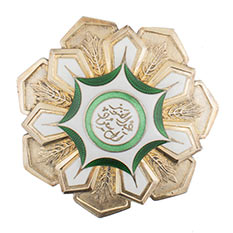
Saudi Arabia
The Kingdom of Saudi Arabia arose in 1932 from the union of the regions conquered since 1902 by Abdulaziz III known as Ibn Saud. The development of Saudi Arabia thrived after World War II with the exploitation of its oil resources.
In the second half of the 20th century, Saudi Arabia gradually set up a particularly rich reward system, comprising numerous orders and decorations. The oldest is the Order of Abdulaziz, named after the King who founded it in 1957. In the center of the insignia is the calligraphy: “Abdulaziz Al Saud”.
Illustration
First class badge of the Order of Abdulaziz


Australia
A constitutional monarchy, a member of the Commonwealth since 1901, Australia established, as did Canada, its own reward system composed of one order and decorations honoring actions of courage and devotion. The Victoria Cross for Australia replaced the British Victoria Cross in 1991. It remains the highest of military distinctions and is awarded exceptionally.
The Order of Australia was founded by letters patent of Elizabeth II, Queen of Australia, on February 14, 1975, to reward both civil and military merits. It comprises four degrees and a medal.
The insignia represents the golden wattle, Australia’s national flower, topped by the crown of Saint Edward, as a tribute to King Edward VII. The center depicts a ring and the word “Australia” below two sprigs of golden wattle. The richness of the decoration and the size of the jewel vary depending on the grade, from the highest, adorned with citrines and the coat of arms of Australia in the center, to the simplest, the plain medal of the Order.
Illustrations
Top, insignia of Companion of the Order of Australia
Bottom, insignia of Officer of the Order of Australia, women’s version
On the map, insignia of Companion of the Order of Australia


China
Until the 19th century, decorations and orders of chivalry were not part of Chinese honorary rewards. Traditional marks of honor consisted of hereditary titles, items of clothing (colorful ceremonial jackets, peacock or raven feathers on hats) or formal concessions (the right to enter the palace on horseback, sedan chair, etc.). Since these were not meaningful to Europeans, Emperor Guangxu instituted the Order of the Precious Star of the Double Dragon in 1882, better known as the Order of the Double Dragon. Initially limited to foreigners, its organization and insignias were complex, much like the rules of protocol of the Empire. For instance, the center stone and the color of the ribbon varied depending on the class of the Order. The theme of the double dragon chasing a pearl is a symbol of the imperial function. This order ceased to exist with the fall of the Chinese empire in 1911.
The first Republic of China (1912-1949) created numerous decorations, some of which were tied to the eventful history of the “Warlords”. Others continued to exist in Taiwan, such as the Order of Brilliant Jade, an order of civil merit founded on December 2, 1933, by Chiang Kai-shek.
The People’s Republic of China, founded in 1949, also developed a diversified system of rewards inspired by the Soviet model.
Illustrations
Top, 3rd class, 2nd grade insignia of the Double Dragon
Bottom, 2nd class badge of the Order of Brilliant Jade
On the map, 3rd class, 2nd grade insignia of the Double Dragon


India
Under British domination in the 19th century, then an integral part of the Empire as of 1857, India was in large part divided into multiple principalities where each maharaja created his own orders. After independence in 1947, the Republic of India developed a reward system with civil and military medals of markedly British inspiration.
Patiala State
The importance of the princely state of Patiala (situated in Punjab in the northwest of India) stems from the essential role it played in the formation of the Sikh Empire and its unfailing loyalty to Great Britain. Maharaja Bhupinder Singh, who reigned from 1900 to 1938, was the most magnificent and noteworthy sovereign of this State. He founded an elaborate system of official rewards including the Order of Krishna, instituted around 1935 and intended a priori for individuals of the Hindu faith. This highly selective order was reserved for five regular members and a few honorary members, often admitted for their diplomatic capacity. The insignia depicts Krishna, prince patron of the Righteous in Hindu mythology, with his consort Radha.
Illustrations
Top, medallion of Maharaja Bhupinder Singh
Bottom, insignia of Cordon of the Order of Krishna
On the map, insignia of Cordon of the Order of Krishna

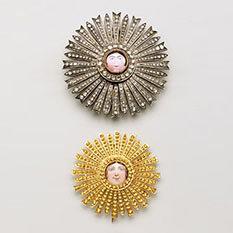
Iran
Arising from Ottoman Persia, Iran was among the first Muslim countries, along with the Ottoman Empire, to adopt the European principle of decorations.
The first order, the Order of the Sun, was founded in 1808 under the Qajar dynasty by Fath Ali Shah to reward general Gardanne, sent on a diplomatic mission by Napoleon I. It was soon changed into the Order of the Lion and Sun, an intricate order, reformed several times but retained and renamed Order of Homayoun by Reza Shah Pahlavi in 1925. It was later modernized on the model of the Legion of Honor.
The Iranian orders reflect both the symbolism of ancient Persian dynasties of Antiquity (Achaemenids and Sassanids) and Muslim symbolism.
Iranian dynasties conferred other prestigious honors such as the Order of the Pleiades for the Pahlavi dynasty and the Order of the Sun for Women for the Qajar dynasty. Both orders were reserved for women.
In 1979 Iran became an Islamic republic, whose constitution provides for the awarding of special medals and decorations by the head of government.
Illustrations
Top, badge of Grand Cross of the Order of Homayoun
Bottom, badges of 1st class of the Order of the Sun for women
On the map, pendant of 1st class of the Order of the Lion and Sun, Qajar era


Japan
Japan opened up to Western influence in the second part of the 19th century with the Meiji era, which restored imperial authority and initiated a policy of modernization of the Empire of the Rising Sun.
An honorary reward system associated with the notion of merit was gradually put into place, comprising orders and numerous commemorative medals (for coronations, imperial weddings, military campaigns, etc.).
The oldest one is the Order of the Rising Sun, a civil and military order exclusively for men founded in 1875.
The most prestigious one is the Supreme Order of the Chrysanthemum (Grand Cordon founded in 1876 and collar in 1888), reserved for the imperial family and foreign dignitaries. There was also an order specifically for women: the Order of the Sacred Crown or precious crown founded in 1888. The symbolism of the insignias of the Order draws mostly on the legendary phoenix Ho-o, which symbolizes the empress and the feminine virtues, justice, obedience and fidelity.
The insignias of the Japanese orders, with clean stylized lines, are presented in highly refined lacquer boxes.
Illustrations
Top, first class insignia of the Order of the Rising Sun
Bottom, first class badge of the Order of the Sacred Crown
On the map, badge of the Order of the Chrysanthemum

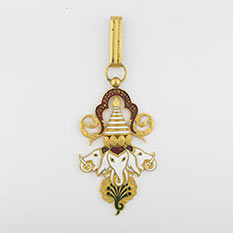
Laos
A landlocked country that stretches between Vietnam and Thailand, Laos was formerly known as Lan Xang, “Kingdom of the Million Elephants”. Founded in the 14th century, it was later divided into several royal states disputed by Siam and Annam in the 19th century. The eastern part of Laos became a French protectorate in 1893 and was incorporated into the French Indochinese Union in 1898. The kingdom was unified under the long reign of Sisavang Vong and became autonomous in 1949. The Kingdom of Laos was abolished in 1975 and replaced by a democratic republic, which founded orders of Soviet inspiration.
The Order of the Million Elephants and the White Parasol, founded by the King of Laos on May 1, 1909, rewarded outstanding civil and military merits. The order had only one class at the time of its creation. It was modified several times and as of 1936 consists of five classes. In Hindu tradition the multi-headed white elephant is a mythical creature that serves as the mount of the god Indra.
Illustrations
Top, badge of Grand Cross of the Order of the Million Elephants
Bottom, insignia of third class of the Order of the Million Elephants
On the map, badge of Grand Cross of the Order of the Million Elephants


Lebanon
Established in 1920 in the aftermath of World War I, the State of Greater Lebanon was placed under French mandate. The independence of the Republic of Lebanon was declared by general Catroux on June 8, 1941, and became effective in 1943.
Lebanon has a reward system composed of two major national orders (Order of Lebanese Merit and National Order of the Cedar), special orders and various medals.
The Medal of Honor of Lebanese Merit, founded in 1922 by the French government in Lebanon, became the Order of Lebanese Merit after independence. In 1930, an extraordinary grade for foreign heads of state was created, endowed with a spectacular insignia depicting the cedar of Lebanon.
Illustrations
Top, insignia of the Order of the Medal of Honor of Lebanese Merit
Bottom, badge of the extraordinary degree of the Medal of Honor of Lebanese Merit
On the map, insignia of the extraordinary degree of the Medal of Honor of Lebanese Merit


Thailand
Since the 16th century the ancient Kingdom of Thailand, formerly known as Siam, managed to avoid Western colonization all while maintaining diplomatic and trade relations with Europe.
Until the middle of the 19th century there were no European-style decorations. The Order of the Nine Gems, reserved for dignitaries of Buddhist faith and members of the royal family, was founded around 1857. It replaced a very ancient insignia of sovereignty composed of a gold chain adorned with nine precious stones that were said to capture the beneficial influences of certain planets associated with each jewel.
The Order of the White Elephant was founded in 1861 to exchange decorations with other countries as part of the rapid opening up of the kingdom to the world. The Order of the Royal House of Chakri was founded in 1882 on the occasion of the 100th anniversary of the dynasty of the same name. It was modeled on the European orders of chivalry with a single class featuring a collar. It was intended for foreign sovereigns and heads of state as well as certain members of the royal family. The shape of the insignia is that of a chakra, a disk with a serrated edge, used as a throwing weapon by the god Vishnu. The center of the badge depicts the unalom, a protective symbol.
Illustrations
Top, insignia of the Order of the White Elephant (Maha Varabhorn 1st class cordon)
Bottom, badge of the Order of the Royal House of Chakri
On the map, badge of the Order of the Nine Gems

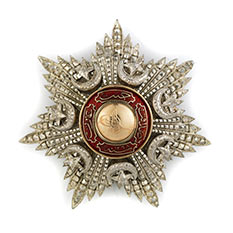
Turkey
At the end of the 18th century, an order of chivalry in the Western sense of the term did not exist in the Ottoman Empire. A system of military rewards was in use with the Chelengk (çelenk), an honorary aigrette worn on the turban. This insignia was exceptionally awarded to admiral Nelson in 1798 after his victory over Napoleon Bonaparte in Abukir.
Soon after that, Sultan Selim III founded the first Ottoman distinction of European inspiration , for foreigners: the Order of the Crescent, replaced circa 1831 by Nichan Iftikhar.
The Imperial Order of Medjidie, founded in August 1852 by Sultan Abdel Medjid, was the first modern Ottoman order. Inspired by the Legion of Honor, it was conferred on British, French and Sardinian officers after the Crimean campaign. The radiating insignia is adorned in its center by the Sultan’s tughra (calligraphic symbol and seal).
The Imperial Order of Osmanieh, founded in 1862, took precedence over the Order of the Medjidie in the ranking of Turkish orders. It was named after Osman, the founder of the Ottoman Empire.
All orders of the Ottoman Empire disappeared upon its fall in 1922, after which the Republic established new decorations.
Illustrations
Top, insignia of the Order of the Crescent
Bottom, badge of the Imperial Order of the Medjidie
On the map, badge of the Imperial Order of Osmanieh


Vietnam
Founded in 1802 under the reign of Gia Long, the empire of Vietnam, “Empire of Annam” to foreigners, was gradually colonized by France and incorporated into the French Indochinese Union founded in 1887 with Laos and Cambodia. The Emperor of Annam then played a formal role.
After the World War II, the country was torn by wars and revolutions. It was reunified in 1976 under the authority of the north as the Socialist Republic of Vietnam.
The Khahn was the highest distinction of the Empire of Annam. It bears the name of the ceremonial gong meant to propagate the good words engraved on its surface. The Khahn decoration bore a personal dedication or an invocation. The Khahn was structured in four classes on the European model at the end of the 19th century and continued to exist for several years in the Republic of Vietnam (South Vietnam). Made in gold, it was named Kim Khahn, and hung from a red cord extended by colorful fringes below the pendant, representing a bat, the symbol of longevity and happiness.
The civil and military National Order of Vietnam, of European inspiration, was founded in 1950 by Bao Dai, then head of State of Vietnam, and later reformed by the Republic of Vietnam (South Vietnam). In 1976, the Socialist Republic of Vietnam abolished it, like all other orders, and replaced it with a reward system of Soviet inspiration.
Illustrations
Top, Kim Khahn, 1st class
Bottom, insignia of Grand Cross of the National Order of Vietnam
On the map, Kim Khahn, 1st class

Ivory Coast
Made a French colony in 1893, the statesman Félix Houphouët-Boigny made a profound mark on the Ivory Coast and became the Republic’s first president. Independent in 1960, the Côte d’Ivoire adopted a reward system in line with the French model with two national orders, special orders and decorations.
The National Order of the Republic was founded on December 10, 1960. Intended for rewarding individual merit and services to the Nation, it represents the highest honor of the State. Its Grand Master, the president of the Republic, wears a collar resembling that of the Legion of Honor both in its inscriptions and in its symbols of the activities of the Nation. The insignia bears the seal of the Republic on the obverse and on the reverse the motto: “Union, Discipline, Travail” (Unity, Discipline, Work).
Illustration
Badge of Grand Cross of the National Order of the Republic

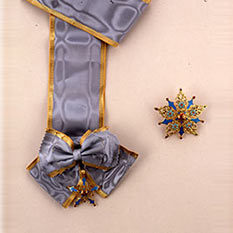
Egypt
The purely Egyptian orders appeared under the British protectorate in 1914 and developed after the promulgation of the monarchy in 1923. Prior to that, under Ottoman guardianship, certain Turkish orders were distributed in the name of the Sultan.
The kingdom of Egypt had numerous orders and decorations. The highest distinction was the elitist Order of Muhammad Ali, named after the first Pasha of Egypt, founded in 1915, whose collar was reserved for the royal family and heads of state. The Order of the Nile, also founded in 1915, was the most common order of merit, used to reward both civil and military services.
The Republic abolished the royal orders and replaced them in 1953 by a comprehensive reward system. At the highest level, the Collar of the Nile and the Grand Cordon of the Nile are reserved for heads of state and of government. The insignia of the Grand Cordon of the Nile represents the river Nile flanked by two figures symbolizing Upper and Lower Egypt.
There are also two orders of merit (Order of the Republic and Order of Merit), special orders, military decorations and an order for women, the Order of al-Kemal, a revival of the royal order of the same name.
Illustrations
Top, badge of Grand Cross of the Order of the Nile
Bottom, badge of the Order of al-Kemal (current version)
On the map, badge of Grand Cordon of the Nile


Ethiopia
The empire of Ethiopia adopted European orders at the end of the 19th century. The most prestigious one was the Order of the Seal of Solomon, founded in 1874 by Negus Yohannes IV. The name of the Order evokes the meeting of King Solomon and of the Queen of Sheba, the founding myth of Ethiopia. It was reorganized by Negus Haile Selassie in 1930 with a special grade of a collar reserved for the Emperor and a few sovereign families. There was also an Order of the Queen of Sheba, with very similar features.
The Order of the Star of Ethiopia —founded by the future Emperor Menelik II, also in 1874— rewarded both civil and military services. Habitually conferred on foreigners and diplomats, it comprised five classes. The first insignias were worn on a long braided silk cord. Later insignias were worn in the European fashion. The chiseled gold insignia came in different shapes depending on the class.
There were also two other orders of civil and military merit: the Order of Menelik II or Order of the Lion of Judah, founded in 1924, and the Order of the Trinity, founded in 1930 on the model of the Legion of Honor. Decorations dating back to the Ethiopian empire were abolished at the time of the coup d’état of 1974. The regimes that followed instituted their own national reward systems.
Illustrations
Top, insignia of the Order of the Seal of Solomon
Bottom, badge of the Order of the Trinity
On the map, insignia of the Order of the Star of Ethiopia


Gabon
Present in the country beginning in 1839, France incorporated Gabon into French Equatorial Africa. A member of the Franco-African Community (1958), Gabon gained independence in 1960 in the form of a republic. It then developed a reward system based on the French model with two main orders: the Order of the Equatorial Star, founded in 1959 with the motto: “Union, Travail, Justice” (Unity, Work, Justice), and the National Order of Merit, founded in 1971.
Illustrations
Top, badge of the Order of the Equatorial Star
Bottom, badge of the National Order of Merit
On the map, insignia of the Order of the Equatorial Star
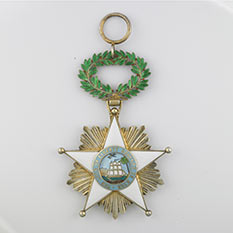

Liberia
Freed black slaves from America colonized this sovereign state that became a republic in 1847. The Republic of Liberia’s history has been turbulent, torn between native Africans and African Americans.
The creation of the first Liberian order was contemporary with that of the first African orders: instituted on January 13, 1879 as the Order of African Liberation, its name was changed in 1897 to the Order of African Redemption. It is conferred to those who have served the country with distinction, including foreigners and diplomats. The Order of the Pioneers of Liberia, founded on January 7, 1955, commemorates the founding of the Republic by former American slaves and is presently the highest distinction of the country.
Illustrations
Top, insignia of Grand Cross of the Order of African Redemption
Bottom, insignia of a Commander of the Order of the Pioneers of Liberia
On the map, insignia of a Commander of the Order of the Pioneers of Liberia

Madagascar
Madagascar, unified as a kingdom in the 19th century under the Merina dynasty, was declared a French protectorate on October 1, 1895, and then a colony on August 6, 1896. The island country obtained its independence in 1960 and has, among other distinctions, a national order that dates back to 1980.
Under the monarchy, each monarch established a new decoration. In March 1896, Queen Ranavalona III (1883-1896) thus instituted the Royal Order of Madagascar or of Ranavalona to reward outstanding services rendered to the kingdom by Malagasies and foreigners alike. The order had five classes and its statutes were inspired by those of the Legion of Honor. The Order disappeared at the time of the annexation of Madagascar by France and the Queen’s exile in 1897.
Illustration
Badge of the Order of Ranavalona

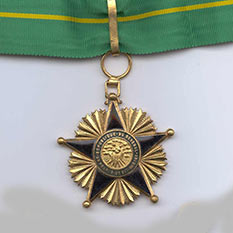
Senegal
The French conquest of the territory, begun in 1659, led to the founding of Dakar in 1857, which became the capital of the federation of French West Africa in 1895. Independent in 1960, the country was governed by Léopold Sédar Senghor, who implemented a reward system directly inspired by French orders.
The National Order of the Lion, founded on October 22, 1960, was modeled after the Legion of Honor. It constitutes the highest distinction of Senegal. Its motto is: “Un Peuple – Un But – Une Foi” (One people, One goal, One faith). It is completed by an Order of Merit, which was founded on the same date.
Illustrations
Top, insignia of a knight of the National Order of the Lion
Bottom, insignia of a Commander of the Order of Merit
On the map, badge of Grand Cross of the National Order of the Lion


Tanzania
The United Republic of Tanzania was formed in 1964 from the union of Tanganyika, a vast continental state placed under British protectorate in 1890 and independent since 1961, and the Sultanate of Zanzibar and Pemba, whose independence was proclaimed in 1963. It currently possesses several orders and decorations, including the Order of the Torch of Kilimanjaro, founded in 1960 and reserved for outstanding merits.
The Order of the Shining Star was one of the orders of the Sultanate of Zanzibar. Founded by the third Sultan of the island, Barghash Bin Said, on September 22, 1875, it comprised two classes, the first restricted to sultans and sovereigns and the second divided into four levels.
Illustrations
Top, insignia of Grand Cordon of the Order of the Torch of Kilimanjaro
Bottom, insignia of the Order of the Shining Star
On the map, insignia of Grand Cordon of the Order of the Torch of Kilimanjaro

Chad
Incorporated into French Equatorial Africa in 1908, the Republic of Chad obtained autonomy in 1958 and independence two years later.
As of 1960, the country devised a classical reward system composed of a national order, special orders and military decorations.
The National Order of the Republic was founded by decree on April 12, 1960. Made to reward devotion to the Republic and civic virtues, it constitutes the highest distinction of the country. It comprises three degrees and two titles. Its motto is: “Unité, Travail, Progrès” (Unity, Work, Progress).
Illustration
Insignia of a knight of the National Order of the Republic
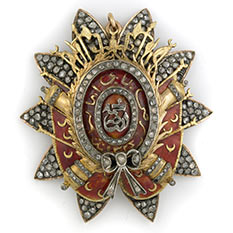

Tunisia
The Regency of Tunis was the only province of the Ottoman Empire to institute decorations in the 19th century. It was the third Muslim country to create rewards, after the Sublime Porte and Persia. The insignias of the Tunisian orders of that time, set with precious stones, are particularly luxurious and uncommon.
The first order, Nichan Iftikhar (Order of Glory), was founded in 1837 by Ahmed Pasha. With time it underwent many modifications, which gradually brought it into conformity with the classical orders of merit inspired by the Legion of Honor. The original decoration was a gold medallion set with diamonds, bedecked with the reigning Bey’s number. In 1857, the insignias were modified to be less costly to produce and closer to European models in the way they were worn.
Founded in 1874, Nichan al-Ahd al-Mourassa (Order of the Inlaid Pact) was reserved for close associates of the Bey and for a few foreign high officials. It is derived from Nichan al-Ahd al-Aman (Order of the Fundamental Pact), representing its highest class in a way.
The Proclamation of Independence in 1956 led to the suppression of all Husainid orders. They were replaced by a reward system comprising national orders, special orders and numerous decorations.
Illustrations
Top, insignia of the Order of Nichan al-Ahd al-Mourassa
Bottom, insignia of the Order of Nichan al-Ahd al-Aman
On the map, insignia of the Order of Nichan Iftikhar
North America

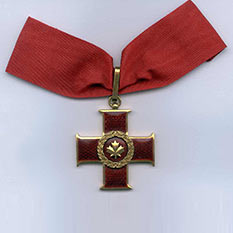
Canada
A member of the Commonwealth, Canada is a federal parliamentary constitutional monarchy with Queen Elizabeth II as its head of state, represented by a Governor General. It was granted independence in 1931 by the Statute of Westminster.
Since 1967 Canada has developed a comprehensive reward system comprising orders, decorations and medals, still awarded in the name of the Queen.
The Order of Canada was instituted for the centennial of the Canadian Confederation on July 1, 1967, to reward exemplary service. It comprises three ranks: Companion, Officer and Member. The Governor General is Chancellor and Principal Companion of the Order, and wears the collar. This strictly limited order is reserved for Canadians (fewer than 150 Companions) and, on an exceptional basis, a few foreigners (honorary members). Since the Order was founded, 4,000 members have been admitted. The design of the insignia is a snowflake featuring a maple leaf. The motto is: “desiderantes meliorem patriam” (they aspire to a better homeland).
The Order of Military Merit, in three degrees, established July 1, 1972, rewards meritorious and exemplary service in Canada’s armed forces.
Some specific decorations for bravery include the Cross of Valor, which has been presented for the most remarkable acts of courage to a mere twenty recipients since it was founded in 1972.
In 1993, Canada created a national Victoria Cross, which has precedence over all orders.
Provinces have established their own orders of merit, which are not recognized by the Federal Government.
Illustrations
Top, insignia of Companion of the Order of Canada
Bottom, Cross of Valour
On the map, insignia of Companion of the Order of Canada


The United States of America
The United States, a democracy since its inception, has developed a comprehensive and intricate set of military and civil medals. The oldest of these, the Badge of Military Merit, was created by George Washington in 1782, in the form of a heart made of purple cloth. It gave rise to the Purple Heart in 1932, a decoration for those wounded in action.
The Medal of Honor is the highest military honor in the United States for acts of valor “above and beyond the call of duty”. It was instituted by the U.S. Congress in 1861 for the Navy, in 1862 for the Army and in 1960 for the Air Force. Awarded by the President of the United States, there have been less than 3500 recipients since its creation, including 124 for World War I and 464 for World War II.
The Distinguished Service Cross and Medal (DSC and DSM), founded in 1918 on the initiative of General Pershing, respectively reward heroism in combat and exceptionally meritorious service. They may be awarded to civilians and foreigners in unusual circumstances in time of war.
The Legion of Merit (LOM) was founded on July 20, 1942, during World War II, so that foreign military leaders could be honored in a manner similar to the DSM. It is the only order of the United States with degrees: Chief Commander, Commander, Officer and Legionnaire. The last is the only one that is awarded to members of the U.S. army.
The award criteria have evolved so that this order has become a means of recognition in times of peace.
Illustration
Top, insignia of the Purple Heart
Bottom, Distinguished Service Medal
On the map, Medal of Honor, Navy version

Guatemala
Guatemala, of Mayan culture, was part of the Spanish colonial empire from 1524 to 1821 and gained independence at the same time as Mexico. It officially became autonomous in 1847. President Jorge Ubico Castañeda, the last of four dictators who had successively run Guatemala since 1839, founded the Order of the Quetzal, the highest and oldest of Guatemala’s honors, on April 23, 1936. It is named after the sacred bird of the Maya, one of the most beautiful birds of Central America with its shimmering plumage.
The national bird, enameled in natural style, is depicted in the center of the insignia with “Libertad, 15 de septembre 1821” inscribed on a parchment scroll.
Illustration
Badge of Grand Officer of the Order of the Quetzal


Mexico
Established as the Viceroyalty of New Spain in a territory with a rich pre-Columbian past, Mexico won independence thanks to general Agustin de Iturbide in 1821. The Emperor founded the first Mexican order during his short reign on February 20, 1822, the Order of Our Lady of Guadalupe, placed under the patronage of the miracle-working Mexican virgin. The Republic was proclaimed in 1823, followed by periods of political instability when liberals and conservatives fought for power. During his last term as president, in 1853, general Antonio Lopez de Santa Anna renewed the Order of Guadalupe, modeling it on Spain’s Order of Charles III.
The country experienced another imperial period under the Second Empire. Napoleon III, who aspired to establish a Catholic Latin empire in Central America, launched a French expedition to Mexico in 1862 and installed Archduke Maximilian of Hapsburg at the head of the country in 1864. The latter, tragically overthrown by the partisans of President Juarez in 1867, founded the Imperial Order of the Mexican Eagle, an order of merit modeled on the Legion of Honor. The Mexican symbolism recalls the legend of the founding of the first Aztec capital, the origins of Mexico: an eagle perched on a nopal (prickly pear) cactus tearing apart the serpent of discord. This Order took precedence over the Order of Guadalupe, which was restored and reformed into five classes. Maximilian’s orders did not outlive the Empire. In 1933 the Republic established an order of merit for foreigners, the Order of the Aztec Eagle, whose symbolism also uses Mexico’s emblem, the eagle.
Illustrations
Top, badge of the Imperial Order of the Mexican Eagle
Bottom, badge of the Order of the Aztec Eagle
On the map, badge of the Order of Our Lady of Guadalupe


Argentina
Under the aegis of Liberator José de San Martín, the independence of the United Provinces of the Rio de la Plata was declared on July 9, 1816. Early Argentina was marked by an ongoing conflict between Federalists and Unitarians. The constitution of 1853 instituted a federal system similar to that of the United States. Numerous medals were generated in Argentina in the 19th century, but with a concern for equality, orders of merit for both Argentineans and foreigners were not established until the 20th century. They were then made unavailable to Argentineans. Today there is a wide range of orders of general and special merit solely for foreigners.
The Order of the Liberator General San Martín, founded on August 17, 1943, is reserved for foreign military and civil servants who have earned the recognition of the Nation. It comprises six grades including a collar for heads of state. The obverse of the insignia features the effigy of general José de San Martín, the hero of independence; the reverse depicts the arms of Argentina.
Illustrations
Top, insignia of Grand Cross of the Order of the Liberator General San Martín
Bottom, badge of Grand Cross of the Order of the Liberator General San Martín
On the map, insignia of Grand Cross of the Order of the Liberator General San Martín

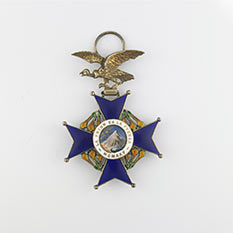
Bolivia
The history of this Andean republic, named Bolivia in homage to Liberator Simón Bolivar, is chaotic. It won its independence in 1825, after the battle of Ayacucho (city of blood in Quechua) on December 9, 1824. After a short-lived confederation with Peru (1836-1839), Bolivia experienced instability like all the other young South American republics. The field of phaleristics is rich and dynamic with a wide variety of medals and orders: Order of the Condor of the Andes, Order of the Legion of Honor of Marshal Andrés de Santa Cruz y Calahumana (reinstated by President Carlos Mesa in 2004), National Order of Simón Bolivar (founded in 1986 in 3 classes), Order of Military Merit (founded in 1927).
The Order of the Condor of the Andes, founded by decree of April 18, 1925, on the occasion of the hundredth anniversary of independence, is Bolivia’s highest distinction. It may be awarded to Bolivian citizens as well as to foreign nationals. It is divided into six classes: Grand Collar, reserved for heads of state, Grand Cross, Grand Officer, Commander, Officer and Knight. Kantuta flowers, the cantua buxifolia in Quechuan, “the flower of the Incas” and also the national emblem since January 1, 1924, are set between the arms of the cross, which suspends from the Andean condor. Its center depicts an enameled condor flying naturally in front of Mount Potosi and the shining sun, also national symbols.
Illustrations
Top, badge of the Order of Condor of the Andes
Bottom, insignia of Knight of the Order of Condor of the Andes
On the map, badge of the Order of Condor of the Andes
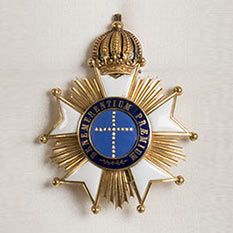

Brazil
A Portuguese colony, Brazil became an associated kingdom when João VI (John VI) was chased out of Portugal by Napoleon’s armies. It remained an empire from 1822 until the overthrow of Pedro II in 1889 and the proclamation of the Republic.
Upon his accession, Pedro I founded three new orders in addition to the reward system inherited from Portuguese orders of chivalry: the Order of the Southern Cross in 1822, the Order of Pedro I in 1826 and the Order of the Rose in 1829.
The Order of the Southern Cross, the first Brazilian order of merit, asserted the independence of the Nation and evokes the original name of Brazil: “Terra de Santa Cruz” (Land of the Holy Cross). The Legion of Honor inspires the insignias: a star enclosed with foliage (tobacco and coffee instead of oak and laurel) and a radiating badge. Retained by the provisional government in 1889, it was abolished in 1891. In 1932 president Vargas restored it for foreigners with an insignia adapted to the Republic: the constellation of the Southern Cross remained, while a symbolic woman’s profile replaced the profile of the founder.
Pedro I, to celebrate his marriage to Amélie of Leuchtenberg, daughter of prince Eugène de Beauharnais and granddaughter of Empress Josephine founded the Order of the Rose in 1829. It was “to perpetuate by a useful institution the memory of happy times and to conserve the memory for posterity”. The motto of the Order was: “Amor e Fidelidade” (Love and Fidelity). This romantic order of merit, adorned with roses in the honor of the young Queen, was abolished in 1891. However, it was used to inspire the insignia of the National Order of Merit, Brazil’s highest honor, founded in 1946.
Illustrations
Top, badge of the Order of the Southern Cross, imperial version
Bottom, Order of the Southern Cross, current version
On the map, badge of the Order of the Rose


Ecuador
The Republic of Ecuador was established in 1830 and its first president, General Juan José Flores, was a hero of the war of independence. Like other young republics of South America, the country experienced extreme political instability, with a succession of popular revolutions and military coups d’état. It was not until the 20th century that the first orders of merit appeared and a comprehensive reward system was developed, including orders of civil and military merit and various medals.
The Order of National Merit was founded on October 8, 1921, and was modified in 1937 and 2002. It rewards outstanding civil merits and may be awarded to foreigners. It comprises five classes plus a special class with a collar for heads of state. The insignias depict three snowy mountains and a shining sun in their center. This motif is taken up by the Medal of Pichincha that was minted after the famous victory of May 24, 1822, which put an end to Spanish domination. It is the symbol of the Republic of Ecuador.
Illustrations
Top, badge of Grand Cross of the Order of National Merit
Bottom, insignia of Grand Cross of the Order of National Merit
On the map, badge of Grand Cross of the Order of National Merit


Peru
The Republic of Peru succeeded the vast and powerful Inca Empire. Its independence was proclaimed in 1821 by Argentinian general José de San Martín, the country’s protector, who authorized the first medals in 1820. The struggle against the royalists then continued with the support of general Simón Bolivar. Thus, Bolivia and Peru together fought for their independence.
Peru has a variety of orders of merit (Order of the Sun, Military Order of Ayacucho, special orders of merit) and medals tracing the numerous conflicts since the war of independence.
The Order of the Sun of Peru is the heir of the Order of the Sun founded on October 8, 1821, by general San Martín and abolished on March 9, 1825. President Augusto Leguia on the occasion of the centenary of Peru’s independence established it on April 14, 1921. It rewards civil and military merits and may be conferred on foreigners. It comprises five classes and is now the highest honor of Peru. The center of the radiating insignia depicts the arms of the country, surrounded by a laurel wreath.
Illustrations
Top, badge of Grand Cross of the Order of the Sun
Bottom, badge of special class of head of state of the Order of Ayacucho
On the map, badge of Grand Cross of the Order of the Sun
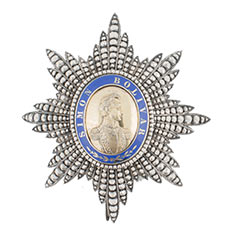

Venezuela
Formerly a part of the Viceroyalty of New Grenada, Venezuela proclaimed its independence on July 5, 1811. It remained the prey of incessant revolutions for more than a century.
A federal country with a vast reward system, it has more than one hundred orders and decorations of merit: civil and military presidential orders (Order of the Liberator, Order Francisco de Miranda, Order Andrés Bello, etc.), civil and military ministerial orders, and the federated states and municipalities’ own orders and rewards.
The Order of the Liberator, founded by decree of September 14, 1880, was the highest in the hierarchy of Venezuelan distinctions. It was derived directly from the medal of distinction with the bust of the Liberator created on March 11, 1854, by the government of José Gregorio Monagas, and indirectly from the medal of Honor of the Liberator created by the constituent congress of Peru on February 13, 1825, in honor of Bolívar and its companions. It was divided into five classes. The president of the United States of Venezuela was the Chief of the Order and wore the corresponding collar. Along with the insignia of their grade, recipients of the first three classes wore different badges: the first class a bust of Bolívar on a background of golden rays, like the insignia, the second class a bust of Bolívar, the third class a badge with the arms of Venezuela in the center. This order was widely awarded to foreigners.
Illustrations
Top, second-class badge of the Order of the Liberator
Bottom, third-class badge of the Order of the Liberator
On the map, second-class badge of the Order of the Liberator










































